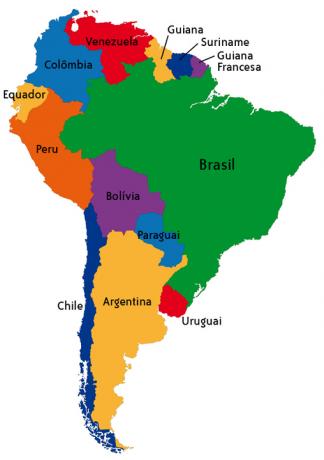Mongolia is an Asian nation located between the territories of Russia and China, with no outlet to the sea. The country has great historical value, as it is heir to the Mongol Empire, in addition to having been inhabited by important nomadic tribes, such as the Huns and Turks.
With a land area of 1,566,500 square kilometers, Mongolia is a sparsely populated country, since its demographic density (relative population) is less than 2 inhabitants per kilometer square. The Mongolian territory has an average altitude of 1,500 meters, sheltering the Gobie Desert and the famous Altai Mountains, which have altitudes above 4,000 meters.
Even with significant improvements in the Gross Domestic Product (GDP), the country faces great economic difficulties. The replacement of the communist system, which was installed in the first half of the 20th century and abandoned in 1990, brought the country's economic relations with China closer together.
Mongolia is an economically poor country, with primary activities being the basis of the national economy. Another important factor for raising revenue is the deposits of gold and copper, in addition to the exploration of uranium.
Socio-economic problems intensified after the transition from communism to a market economy. Currently, more than half of the population lives below the poverty line. It is estimated that 29% of the inhabitants are undernourished and the infant mortality rate is 42 deaths per thousand live births.
Do not stop now... There's more after the advertising ;)

Mongolian Coat of Arms
Mongolian Data:
Territorial extension: 1,566,500 km².
Location: Asia.
Capital: Ulan Bator.
Climate: Temperate continental arid (to the south) and cold arid (to the north).
Government: Parliamentary Republic.
Administrative division: 21 provinces and 1 municipality (Ulan Bator).
Languages: Mongolian (official), Kazakh.
Religions: Traditional beliefs 31.6%, no religion 30.2%, Buddhism 22.5%, atheism 8.8%, Islam 4.8%, Christianity 1.5%, other 0.6%.
Population: 2,670,966 inhabitants. (Men: 1,320,984; Women: 1,349,982).
Composition: Mongols 90%, Kazakh 4%, Chinese 2%, Russians 2%, other 2%.
Demographic density: 1.7 inhab/km².
Average annual population growth rate: 1.1%.
Population residing in urban areas: 57.26%.
Population residing in rural areas: 42.74%.
Undernourished population: 29%.
Life expectancy at birth: 66.3 years.
Households with access to clean water: 72%.
Households with access to a health network: 50%.
Human Development Index (HDI): 0.622 (average).
Currency: Tugrik.
Gross Domestic Product (GDP): 5.3 billion dollars.
GDP per capita: $1,481.
External relations: World Bank, IMF, WTO, UN.
By Wagner de Cerqueira and Francisco
Graduated in Geography
Brazil School Team
countries - geography - Brazil School
Would you like to reference this text in a school or academic work? Look:
FRANCISCO, Wagner de Cerqueira and. "Mongolia"; Brazil School. Available in: https://brasilescola.uol.com.br/geografia/mongolia.htm. Accessed on June 28, 2021.

